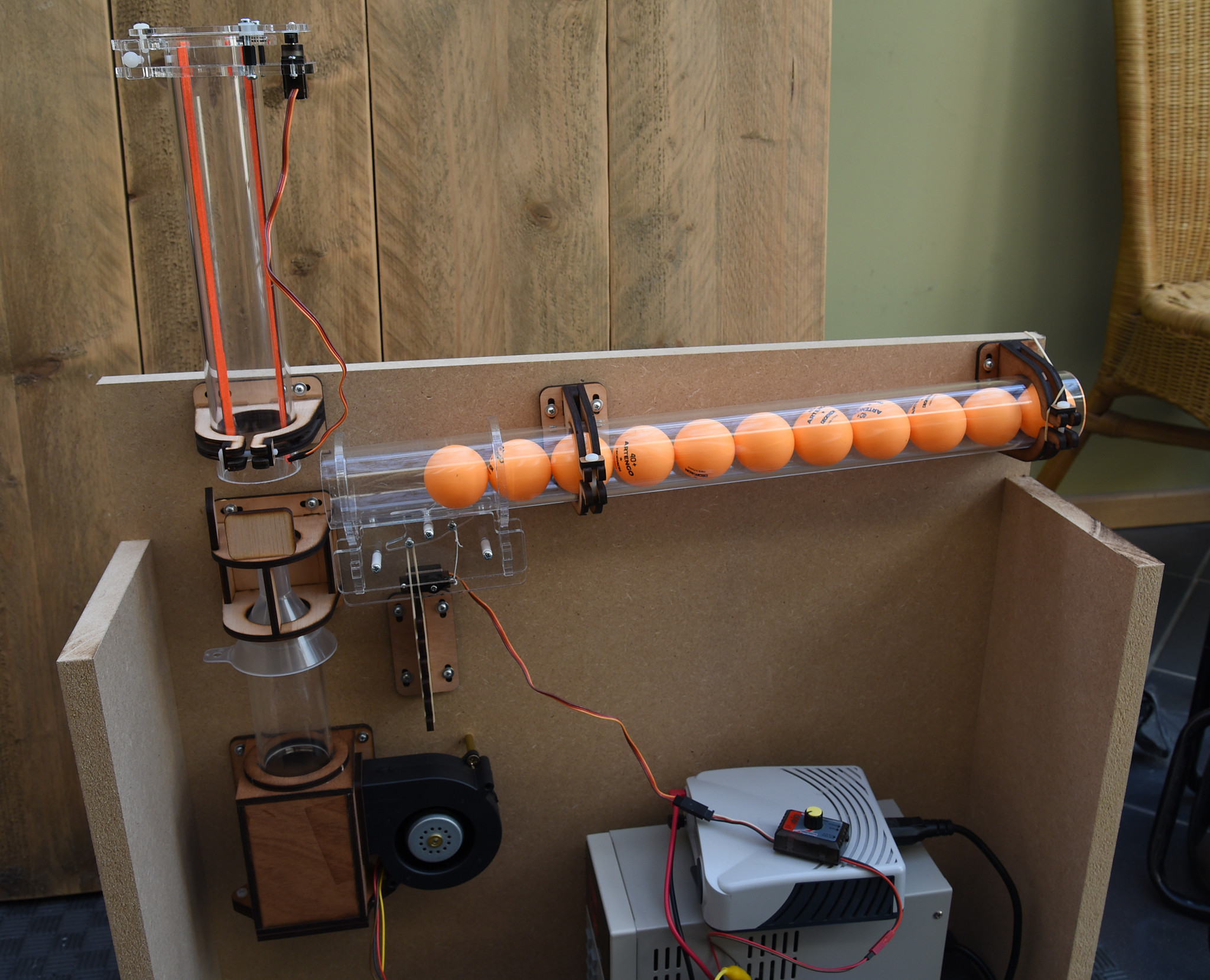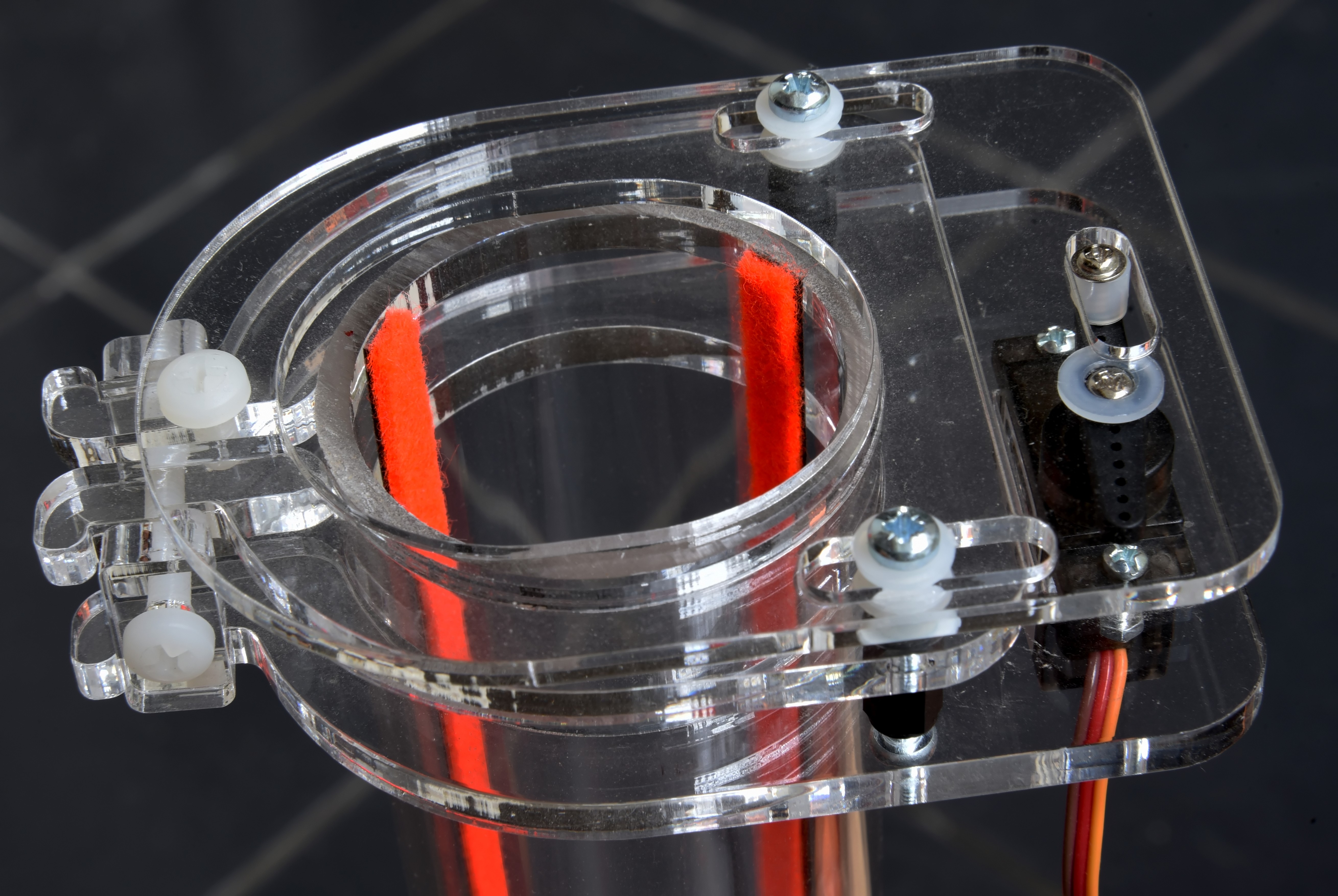DIY Ping-Pong Ball Dispenser
on

Nixie tubes were hard to come by during the height of the COVID-19 crisis, so Ilse Joostens had to focus on Nixie-free projects. This DIY ping-pong ball dispenser is a great example.
Ilse Joostens is no stranger to our loyal Elektor readers — not only as the author of the column “From Life’s Experience,” but also as a master of vintage Nixie and VFD tubes. The Corona pandemic with its lockdowns and other sufferings has not left her untouched either, as the story below describes. The origins of the device that features in this episode of "HomeLab Tours..." goes back many years. We let Ilse do the talking:
“About 20 years ago, I was living as a single in Dendermonde and looking for joining an association to engage in activities. By coincidence, there was a shooting society near my apartment; I became a member. Regularly, what was called ‘fun shooting,’ involved shooting ping-pong balls floating on compressed air. The annoying thing was that every time the ping-pong balls were hit, all weapons had to be unloaded (of course) and someone had to place new ping-pong balls in the air stream. That’s where the idea was born to feed ping-pong balls through a tube at the push of a button, but no one had any idea how that would work mechanically because the idea is, of course, that the balls should come out one by one. I then sketched a draft on a piece of paper, but ultimately I did nothing with the idea.”
 Interested in DIY electronics, pro engineering solutions, and interviews with top engineers? Watch Elektor livestreams! Follow us on Elektor TV and Elektor TV Industry.
Interested in DIY electronics, pro engineering solutions, and interviews with top engineers? Watch Elektor livestreams! Follow us on Elektor TV and Elektor TV Industry.
Meanwhile, Ilse had established herself as an independent electronics designer, specializing in vintage electronics components such as Electrontubes, Nixies and Vacuum Fluorescent Displays (VFDs). There was a very practical reason for this — many things were already designed, and even then the competition from China was already strong. (During the COVID-19 crisis, the Chinese acquired virtually all remaining stocks of Russian Nixie tubes. That is one of the reasons why Elektor’s six-digit Nixie clock is no longer available.) The choice for a niche market was then obvious.
“Thanks to COVID-19, I became quite bored; my shooting society was also closed for the time being. In order to practice a bit at home, I decided to buy a few air-pressure and airsoft guns. It was also a welcome pastime during the lockdowns.”
Due to a lack of Nixie tubes and Plexiglas (also a result of COVID-19), Ilse wanted to change direction in terms of electronics, but it had to be something special. And that’s where the idea with the ping-pong balls came around the corner again, with the idea of shooting them at home with air guns. Something similar can be seen at fairs: at shooting stalls where you can shoot at ping-pong balls floating on water jets (Figure 1).

“Currently, I have only built an operating mechanical prototype. As for the airflow, I used a 9BMC24P2G001 blower from Sanyo Denki. It is not a cheap one, unfortunately, but it delivers a solid airflow and can be easily controlled in speed by a PWM signal. This is convenient because by modulating the airflow, we can cause the ping-pong ball to move up and down irregularly to make it a bit more challenging target. Using a removable cabinet that also serves as a buffer bin and a powder funnel from a chemical wholesaler, a powerful constant airflow is generated. Any debris (bits of projectiles) cannot enter the blower in this way, and you can open the bottom of the cabinet to clean it.”

“The ping-pong balls are stored in a slanting container made of a Plexiglas tube (diameter 50 mm, inner diameter 44 mm, Figure 2). Gravity causes them to roll in the direction of the airflow; there are no restrictions on the size of the container. The prototype can contain up to 11 ping-pong balls, but a supply through a funnel in the container is possible in addition to a longer tube. A rotating plastic cam causes the ping-pong balls to roll out from the container one by one. With each back-and-forth movement of the cam, one ping-pong ball is released while the remaining balls are automatically blocked. The cam is held in a basic position by a tension spring with the cam being moved by a miniature servo using a string (see Figure 3).”

“Such a mechanism could also be the basis of a Nespresso capsule machine. Something with several tubes next to each other. You then select which capsules you want and they drop into a tray at the bottom where you can take them out. I have been thinking about this idea for some time, but I haven’t done anything specific yet.”
The ball that rolls out of the container then enters the airflow above the opening of the powder funnel and is then catapulted into the vertical Plexiglas tube. Two strips of felt are adhered in the tube to prevent the ball from ‘rattling’ in the tube. This can happen when the ball keeps quickly moving in the tube while the air flows between the ball and the wall of the tube.
“If the vertical tube were open at the top, the ping-pong balls would be launched upwards without getting caught in the airflow. Maybe that’s an idea for a table tennis ping pong ball dispenser? To prevent the launching of the ping-pong balls, there is a slide at the top of the tube that is also controlled by a miniature servo (Figure 4). The ping-pong balls now shoot up to the top of the tube until the slide. When the slide then slowly opens, the ball moves up a little and then dances up and down for a while until it remains stable on the airflow. From then on, the blower can be modulated with a PWM signal to make the ball’s behaviour a bit more unpredictable. In practice, the ball floats about 15 to 20 cm above the end of the slide. I also tried experiments without a vertical tube, but then the ball was less stable and regularly fell out of the airflow.”

Basically, you can use any kind of shooting equipment to aim at the ping-pong ball — even a bow and arrow. It is important, however, to use the cheapest possible ping-pong balls as they will not have an extremely long life; preferably, they should also have a contrasting colour.
“Immediately after building the mechanical part, the issues with a shortage of parts started. The blower is currently no longer available (at least not in the short term) so an alternative should already be found for that. As for the rest of the electronics, it is not that critical as basically only two miniature servos need to be controlled and another PWM signal should be generated for the blower. At the moment, the project is on hold, partly due to the war in Ukraine. I find it less appropriate to release a shooting game with all the misery on TV and in the media.”
“Currently, I am not sure how to proceed and whether this project has any potential. At least a remote control would be required. With each press of the button, you would get a new ping-pong ball, possibly with an indicator of the remaining stock of balls. For the latter, you could add IR reflection sensors on the container tube. Other additional options could be a choice between floating or ‘launching’ the ball or a choice of whether or not to modulate the blower. What I would like to know is whether there would be any interest in this, and any suggestions and requests for additional (or different) functionality. In principle, it should be possible to offer a kit with mechanical parts, as everything can be easily cut by laser and glued together. Only the electronics are and will remain an issue at least until mid-2023.”
Questions About the Ping-Pong Dispenser?
Do you have technical questions or comments regarding this article? Send an e-mail to the editors of Elektor at editor@elektor.com.
(210591-01) Translated from Dutch to English by Hans Adams. Edited by Eric Bogers (Elektor). Planned for the May/June edition of Elektor.


Discussion (0 comments)